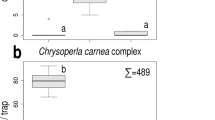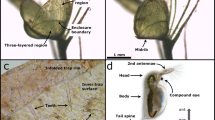Abstract
SINCE the end of May 1955, a light-trap for insects has been in use every night at Kincraig, in the Spey Valley of Inverness-shire, as part of an investigation of the relationship of weather conditions and insect activity. This work is being carried out on behalf of the Agricultural Research Council.
This is a preview of subscription content, access via your institution
Access options
Subscribe to this journal
Receive 51 print issues and online access
$199.00 per year
only $3.90 per issue
Buy this article
- Purchase on Springer Link
- Instant access to full article PDF
Prices may be subject to local taxes which are calculated during checkout
Similar content being viewed by others
References
Williams, C. B., Proc. Roy. Ent. Soc. Lond., A, 23, 80 (1948).
Williams, C. B., Bull. Ent. Res., 46, 193 (1955).
Johnson, G. G., Ann. App. Biol., 37, 80 (1950).
Author information
Authors and Affiliations
Rights and permissions
About this article
Cite this article
WILLIAMS, C., DAVIES, L. Simuliidae attracted at Night to a Trap using Ultra-Violet Light. Nature 179, 924–925 (1957). https://doi.org/10.1038/179924b0
Issue Date:
DOI: https://doi.org/10.1038/179924b0
This article is cited by
-
Studies on the nocturnal periodicity of six species of black flies (Diptera: Simuliidae) at Darjeeling, West Bengal
Proceedings / Indian Academy of Sciences (1974)
-
Nocturnal Activity of Black Flies (Simuliidae)
Nature (1964)
Comments
By submitting a comment you agree to abide by our Terms and Community Guidelines. If you find something abusive or that does not comply with our terms or guidelines please flag it as inappropriate.



